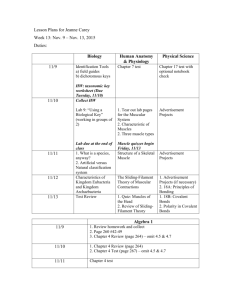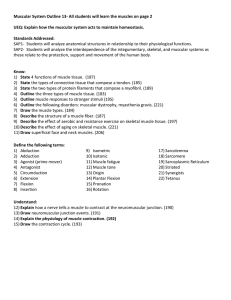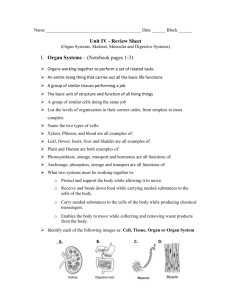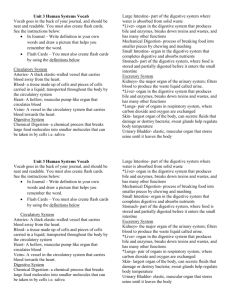APRST8 Diges Urinary & Muscle
advertisement
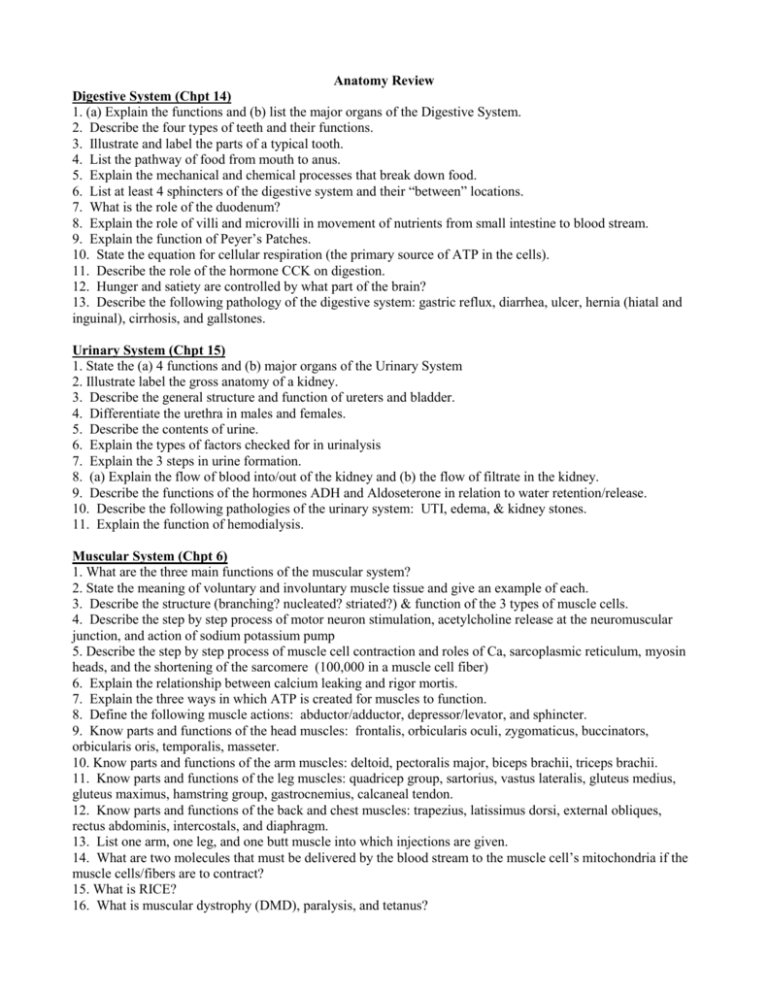
Anatomy Review Digestive System (Chpt 14) 1. (a) Explain the functions and (b) list the major organs of the Digestive System. 2. Describe the four types of teeth and their functions. 3. Illustrate and label the parts of a typical tooth. 4. List the pathway of food from mouth to anus. 5. Explain the mechanical and chemical processes that break down food. 6. List at least 4 sphincters of the digestive system and their “between” locations. 7. What is the role of the duodenum? 8. Explain the role of villi and microvilli in movement of nutrients from small intestine to blood stream. 9. Explain the function of Peyer’s Patches. 10. State the equation for cellular respiration (the primary source of ATP in the cells). 11. Describe the role of the hormone CCK on digestion. 12. Hunger and satiety are controlled by what part of the brain? 13. Describe the following pathology of the digestive system: gastric reflux, diarrhea, ulcer, hernia (hiatal and inguinal), cirrhosis, and gallstones. Urinary System (Chpt 15) 1. State the (a) 4 functions and (b) major organs of the Urinary System 2. Illustrate label the gross anatomy of a kidney. 3. Describe the general structure and function of ureters and bladder. 4. Differentiate the urethra in males and females. 5. Describe the contents of urine. 6. Explain the types of factors checked for in urinalysis 7. Explain the 3 steps in urine formation. 8. (a) Explain the flow of blood into/out of the kidney and (b) the flow of filtrate in the kidney. 9. Describe the functions of the hormones ADH and Aldoseterone in relation to water retention/release. 10. Describe the following pathologies of the urinary system: UTI, edema, & kidney stones. 11. Explain the function of hemodialysis. Muscular System (Chpt 6) 1. What are the three main functions of the muscular system? 2. State the meaning of voluntary and involuntary muscle tissue and give an example of each. 3. Describe the structure (branching? nucleated? striated?) & function of the 3 types of muscle cells. 4. Describe the step by step process of motor neuron stimulation, acetylcholine release at the neuromuscular junction, and action of sodium potassium pump 5. Describe the step by step process of muscle cell contraction and roles of Ca, sarcoplasmic reticulum, myosin heads, and the shortening of the sarcomere (100,000 in a muscle cell fiber) 6. Explain the relationship between calcium leaking and rigor mortis. 7. Explain the three ways in which ATP is created for muscles to function. 8. Define the following muscle actions: abductor/adductor, depressor/levator, and sphincter. 9. Know parts and functions of the head muscles: frontalis, orbicularis oculi, zygomaticus, buccinators, orbicularis oris, temporalis, masseter. 10. Know parts and functions of the arm muscles: deltoid, pectoralis major, biceps brachii, triceps brachii. 11. Know parts and functions of the leg muscles: quadricep group, sartorius, vastus lateralis, gluteus medius, gluteus maximus, hamstring group, gastrocnemius, calcaneal tendon. 12. Know parts and functions of the back and chest muscles: trapezius, latissimus dorsi, external obliques, rectus abdominis, intercostals, and diaphragm. 13. List one arm, one leg, and one butt muscle into which injections are given. 14. What are two molecules that must be delivered by the blood stream to the muscle cell’s mitochondria if the muscle cells/fibers are to contract? 15. What is RICE? 16. What is muscular dystrophy (DMD), paralysis, and tetanus?


